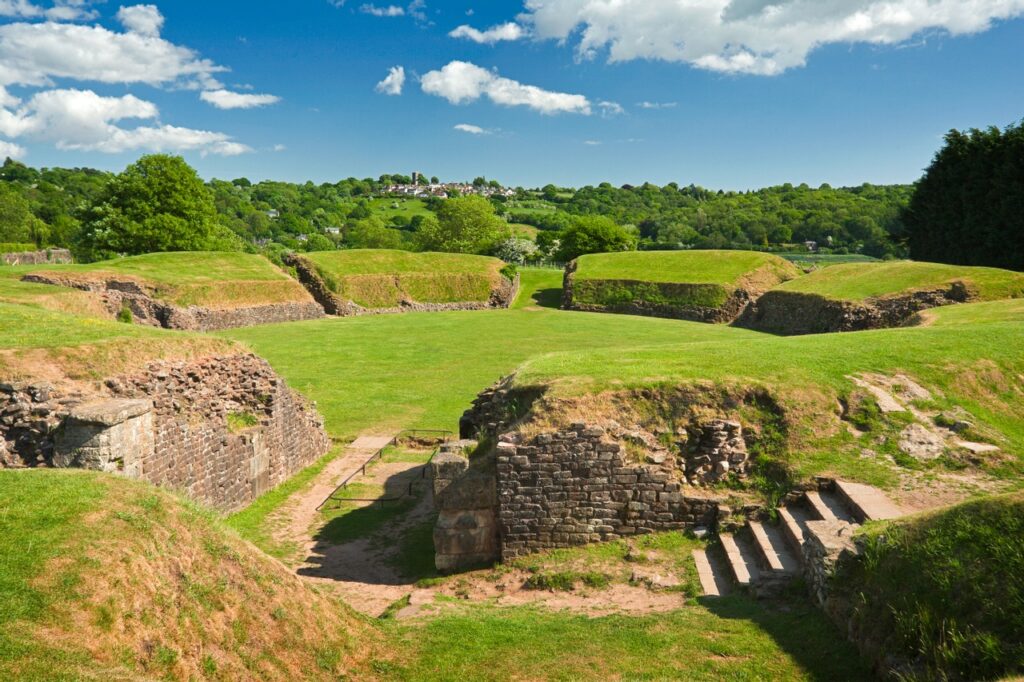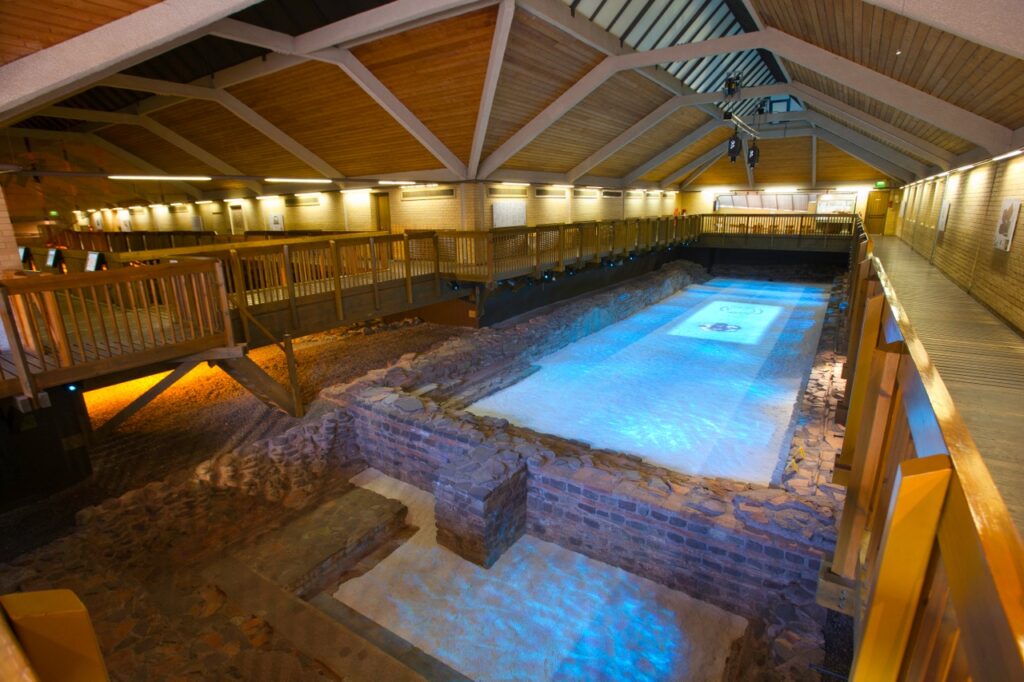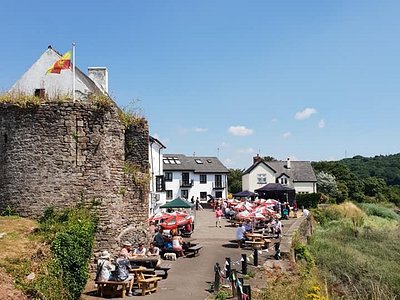Caerleon

CAERLEON, a residential suburb of Newport, was one of the most important military sites in Britain under the Roman Empire, home of the 2nd Augustan Legion and housing 5,000 soldiers and horsemen, with amphitheatre, baths, shops and temples.
Today Caerleon is an attractive historic town with a selection of pubs, restaurants and tea rooms.
Lying on the River Usk, Caerleon was the Roman fortress of Isca, which was, with Deva (Chester) and Eboracum (York), one of the permanent legionary bases in Britain.
The foundation of the fortress, set on a terrace in a wide bend of the Usk, is dated back to the final conquest of the Silures of south-eastern Wales.
Caerleon, traditionally associated with the legendary King Arthur by Geoffrey of Monmouth, was a Welsh kingdom and lordship, mainly in Welsh hands until 1217, and thereafter it was a marcher (border district) lordship. The medieval borough enjoyed a brisk coastal trade that was eventually overtaken by the development of Newport, a little downstream to the south-west.
During the Glyndŵr Rising in 1402 Rhys Gethin, General for Owain Glyndŵr, took Caerleon Castle together with those of Newport, Cardiff, Llandaff, Abergavenny, Caerphilly and Usk by force. This was probably the last time Caerleon castle was ruined, though the walls were still standing in 1537 and the castle ruins only finally collapsed in 1739 – their most obvious remnant is the Round Tower at the Hanbury Arms public house. The Tower is a Grade II listed building.
Across the Afon Lwyd from Caerleon, in the region of Penrhos Farm, are two Civil War forts. In 1648 Oliver Cromwell’s troops camped overnight on Christchurch Hill, overlooking Newport, before their attack on Newport Castle the next day.
Until the Victorian development of the downstream docks at Newport Docks, Caerleon acted as the major port on the River Usk. The wharf was located on the right bank, to the west of today’s river bridge which marked the limit of navigability for masted ships. A tinplate works and mills were established on the outskirts of the town, in Ponthir, around this time, and Caerleon expanded to become almost joined to Newport.
A plaque on the Mynde wall in High Street references the Newport Rising of 1839 in which John Frost of Newport was a prominent figure in the Chartist movement. John Jenkins, owner of Mynde House and owner of Ponthir Tinplate Works, built the wall to keep demonstrators out.
The name of the former Drovers’ Arms on Goldcroft Common bore witness to the ancient drovers’ road on the old road from Malpas. It is thought that the common itself was once the site of a cattle market.
Writing in 1951, local historian and folklorist Fred Hando described the Yuletide traditional journey through Caerleon of the Mari Lwyd or ‘Venerable Mary’, involving a man dressed with a horse’s skull. The jaw of the skull could be made to move, with the aid of rods.
On occasion, the procession of the Mari Lwyd would start as far north as Newbridge-on-Usk and proceed through the town, ending as far south as Goldcliff.
Caerleon features frequently in various works connected with Welsh mythology and Medieval Welsh literature.
In his 1191 Itinerarium Cambriae, written about a tour of Wales in 1188 to recruit for the Third Crusade, the author Gerald of Wales says of Caerleon, “the Roman ambassadors here received their audience at the court of the great king Arthur.”
Geoffrey makes Arthur’s capital Caerleon and Thomas Malory has Arthur re-crowned there. The still extant amphitheatre at Caerleon has been associated with Arthur’s ‘Round Table’ and has been suggested as a possible source for the legend.
Though the huge scale of the ruins along with Caerleon’s importance as an urban centre in early medieval Kingdom of Gwent may have inspired Geoffrey, the main historical source for Arthur’s link with “the camp of the legion” is the list of the 12 battles of Arthur in the 9th-Century Historia Brittonum.
Today, Caerleon has a modern statue of a knight, ‘The Hanbury Knight’, in reflecting stainless steel by Belgian sculptor Thierry Lauwers.
Caerleon is centred around a small common. Goldcroft Common is the only remaining of the seven commons of Caerleon. Most of the small businesses of Caerleon are near the common, as is the Town Hall which has a World War I and World War II memorial garden.
Buildings of note are Saint Cadoc’s Church, the National Roman Legion Museum, the Roman Baths Museum, The Mynde, The Priory Hotel, Caerleon Catholic Church and Rectory, Caerleon Endowed School, the Round Tower, the Toll House at Caerleon Bridge, The Malt House hotel, former University of South Wales Caerleon Campus and St Cadoc’s Hospital.

The historic remains of the Roman Legionary Fortress Isca Augusta is popular with tourists and school parties and there is a marked heritage trail in the town. The Millennium Wildlife Garden is a small nature garden on the banks of the River Usk. The hilltop vantage point at Christchurch provides panoramic views of the Vale of Usk and Bristol Channel.
Ffwrrwm Arts and Crafts Centre is a small specialist shopping courtyard with a gallery restaurant and an eclectic display of sculpture.

Caerleon is a part of the Newport Half Marathon route, entering the town via the National Cycle Route 88 path, into the historic village centre past the amphitheatre, over Caerleon Bridge and onto Caerleon Road back towards the city centre finish.
In July 2018 the Velothon Wales included Caerleon on a 140km route, as well as two shorter routes of 125km and 60km. The Tour de Gwent has a 93-mile route and other distances for different ability levels on offer. It begins in Caerleon and heads to Abergavenny, returning to Caerleon via the Wye Valley.
Caerleon has twice hosted the British national cycling tournament, in 2017 and 2018.
The local ward golf club was included in promotional material for the 2010 Ryder Cup which was hosted at the nearby Celtic Manor Resort.
Caerleon Golf Club is owned by the Celtic Manor Resort, and is a nine-hole municipal course, driving range and golf clubhouse.
Caerleon Bowls Club has a good quality outdoor green and became home of the city’s Newport Athletic Bowls Club when it moved from Rodney Parade.
The town has an association football club, Caerleon AFC, along with two rugby union clubs; Newport High School Old Boys RFC and Caerleon RFC whose grounds are less than a mile apart.
Bulmore Lido was opened in Caerleon in July 1934 land with an open-air swimming pool, cafe and restaurant, closing in the 1980s.
Caerleon began hosting an arts festival in 2003, established initially to welcome participants and sculptors from around the world. Many of the sizeable sculptures are retained around Caerleon as a sculpture park and local landmarks. The arts festival coincides with the Roman military re-enactment in the amphitheatre which demonstrates Roman military armour, infantry tactics, cavalry tactics, equipment and siege engines such as ballistae.
St Cadoc’s Hospital in Caerleon has been featured as a location of episodes in the BBC television programmes Doctor Who and Being Human. The former campus of the University of South Wales was one of the filming sites of the Netflix series Sex Education.
Back to HOME PAGE